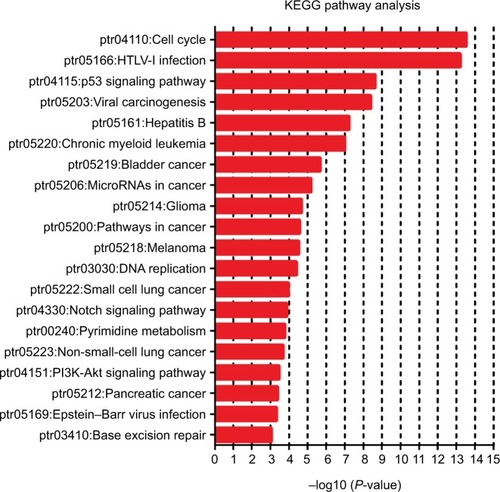Abstract
Background
A growing body of evidence suggests that E2Fs, by regulating gene expression related to cell cycle progression and other cellular processes, play a pivotal role in human cancer. However, the distinct roles of each E2F in the development and treatment of hepatocellular carcinoma (HCC) remain unknown. In the present study, the mRNA expression and prognostic value of different E2Fs in HCC are analyzed.
Materials and methods
Transcriptional and survival data related to E2F expression in patients with HCC were obtained through ONCOMINE and UALCAN databases. Survival analysis plots were drawn with Kaplan–Meier Plotter. The sequence alteration data for E2Fs were obtained from The Cancer Genome Atlas and c-BioPortal. Gene functional enrichment analyses were performed in Database for Annotation, Visualization and Integrated Discovery.
Results
The mRNA expression levels of E2F1–E2F8 were all significantly upregulated in HCC patients, and high expression of each E2F was obviously related to poor prognosis. Similarly, the expression of E2Fs showed prognostic prediction value in HCC patients with different cancer stages and pathological grades. Moreover, the mutation rate of E2Fs was relatively high in HCC patients, and the DNA sequence alterations primarily occurred in E2F5, E2F3, and E2F6, which were associated with worse overall survival and disease-free survival in HCC patients. Network analysis confirmed that the expression levels of cell cycle-related genes were mostly affected by E2F mutations.
Conclusion
High expression of individual E2Fs was associated with poor prognosis in all liver cancer patients. E2Fs may be exploited as good prognostic targets for comprehensive management of HCC patients, but this notion should be further evaluated in clinical studies.
Introduction
Hepatocellular carcinoma (HCC) is the sixth most common, aggressive cancer and the third leading cause of cancer-associated mortality worldwide.Citation1,Citation2 Unfortunately, to date, the precise molecular mechanisms involved in the development, progression, and metastasis of HCC remain largely unknown despite tremendous efforts in the past decades. Moreover, the incidence of HCC is increasing rapidly, and only ~9% of HCC patients survive for >5 years.Citation3 The poor prognosis of HCC is largely attributed to the rapid progression of this disease.Citation4–Citation6 Advances in HCC treatment will no doubt depend on a better understanding of the biology and behavior of HCC. Recently, the mammalian E2F family of transcription factors has been found to have a close relationship with HCC, which may help in finding novel prognostic and therapeutic targets for HCC.Citation7 The mammalian E2Fs lay downstream of cell cycle signaling and play a crucial role in control of cell proliferation, differentiation, senescence, and apoptosis as well as other cellular processes by regulating the expression of a large number of targeted genes related to cell cycle progression.Citation8–Citation10 Since the discovery of the first member, E2F1, in the 1980s, a total of eight E2Fs, E2F1–E2F8, have been identified in mammalian cells.Citation11,Citation12 Conventionally, these eight E2Fs are classified into three categories based on their functional properties and structural features: activator E2Fs (E2F1–E2F3), repressor E2Fs (E2F4–E2F5), and inhibitor E2Fs (E2F6–E2F8).Citation13 In mammalian cells, E2Fs form a network with retinoblastoma protein (pRb) and cyclin-dependent kinases (CDKs) to participate in regulation of the transcriptional activities of cell cycle-related genes.Citation14 Given their important roles in cell cycle regulation, E2Fs are reportedly associated with the development and progression of various types of human cancer.Citation15,Citation16 In recent years, a growing body of evidence has indicated that E2Fs are intimately associated with HCC. For example, E2F1 and E2F3 have been found to be substantially upregulated in HCC tissues compared with adjacent nontumoral tissues.Citation17,Citation18 E2F5 was significantly overexpressed in primary HCC, and knockdown of E2F5 repressed the growth of HCC cells.Citation19 Similarly, E2F8 was also reported to contribute to the oncogenic potential of HCC by upregulating cyclin D1 transcription and enhancing the accumulation of S-phase cells.Citation20
Though their relationship with human cancer is clear, the function of E2Fs in cancer varies. Certain E2Fs, such as E2F3 and E2F4, have been reported to contribute to carcinogenesis, while others, such as E2F1, exhibit tumor suppressive properties in mouse models and specific human cancer types through an unknown mechanism. More surprisingly, even the function of individual E2Fs in the same tumor can be controversial.Citation21 For example, dysregulation of E2F1 can either promote or inhibit tumorigenesis.Citation7 Thus, analyzing the expression, mutation, and prognostic values of different E2Fs in HCC patients via bioinformatics analysis may help to further distinguish their potential roles in HCC. In this study, we address this problem.
Materials and methods
Ethics statement
The study protocol was approved by the Ethics Committee of the Third Affiliated Hospital of Sun Yat-sen University for Human Study and conducted according to the principles of the Declaration of Helsinki. All the data were retrieved from published literature.
ONCOMINE database analysis
The ONCOMINE database (www.oncomine.org), an integrated online cancer microarray database for DNA or RNA sequence analysis, aims at facilitating discovery from gene-wide expression analyses.Citation22 In this study, data regarding transcriptional expression of E2Fs between cancer samples and corresponding normal control liver samples were obtained from the ONCOMINE database, and the differences were compared using Student’s t-test. The cutoff P and fold-change values were as follows: P-value: 0.05; fold change: 1.5; gene rank: 10%; data type: mRNA. Significant correlations are shown in .
Figure 1 E2F gene expression in 20 different cancer types.
Notes: E2F1–E2F8 mRNA expression (cancer tissue vs normal tissue) was analyzed using the ONCOMINE database. The numbers in colored cells show the quantities of datasets with statistically significant mRNA overexpression (red) or underexpression (blue) of target genes. Cell color was determined by the best gene rank percentile for the analysis within the cells. The number in each cell represents the number of analyses that satisfied the threshold, such as gene rank percentile (10%), P-value (0.05), and fold change (1.5).
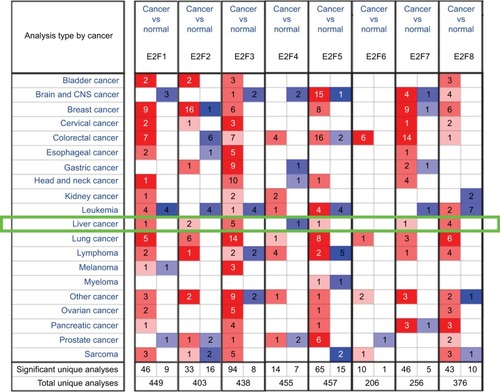
UALCAN
UALCAN (http://ualcan.path.uab.edu) is a newly developed web portal based on level 3 RNA-seq and clinical data from 31 cancer types in The Cancer Genome Atlas (TCGA) database. UALCAN provides web resources that allow cancer researchers and clinicians to analyze the relative expression of a query gene(s) across tumor and normal samples and relative clinicopathologic parameters, obtain a survival plot to estimate the effect of a gene expression level and clinicopathologic parameters on patient survival, and identify novel genes in various individual cancer types.Citation23
The Kaplan–Meier plotter
The prognostic value of the expression of featured E2Fs was analyzed using an open online database, Kaplan–Meier (http://kmplot.com/analysis), which was established using gene expression data and survival information for liver cancerCitation24 and four other types of cancer, namely, breast cancer, ovarian cancer, lung cancer, and gastric cancer.Citation24–Citation27 The desired probe ID was determined according to the file of probe sets provided by K–M plotter. Briefly, eight different E2Fs were entered into the database (http://kmplot.com/analysis/index.php?p=service&cancer=liver_rna-seq). The cancer patients were divided into high and low expression groups according to the median mRNA expression values and validated by K–M survival curves. The number-at-risk cases, median mRNA expression levels, HRs, 95% CIs, and P-values were displayed on the K–M plotter webpage. A P-value <0.01 was considered statically significant.
TCGA and c-BioPortal databases
TCGA, a comprehensive and coordinated project designed to improve diagnosis methods, treatment standards, and ultimately prevent cancer, has helped TCGA users analyze large groups of over 30 human tumors through application of genome analysis technologies, including large-scale genome sequencing and pathological data analysis.Citation28 c-BioPortal (www.cbioportal.org) is an online open-access resource for exploring, visualizing, and analyzing multidimensional cancer genomics data.Citation29 In this study, c-BioPortal was used to access liver HCC (TCGA, Provisional) data. The selected genomic profiles contained mutations, putative copy number alterations from GISTIC and mRNA expression Z-scores (RNASeq V2 RSEM). Eight target genes were automatically calculated using Z-score ±2.0. OncoPrint, overall survival (OS), or disease-free survival (DFS) plotter were obtained according to the online instructions in c-BioPortal.
Gene Ontology (GO) and Kyoto Encyclopedia of Genes and Genomes (KEGG) pathway enrichment analysis
The Database for Annotation, Visualization and Integrated Discovery (DAVID; https://david.ncifcrf.gov/)Citation30 was used to perform GO and KEGG analyses of eight E2F genes. The human genome was selected as the background parameter. P<0.05 was set as the threshold to indicate a statistically significant difference.
Results
Transcriptional expression of different E2Fs in patients with HCC
Eight E2Fs have been identified in the human genome, and their mRNA expression levels in human cancer have been determined using the ONCOMINE database. As shown in , we first calculated the expression levels of E2Fs in 20 types of cancer compared with adjacent nontumoral tissues. Noticeably, as shown in , E2F mRNA expression was significantly upregulated in HCC samples, except E2F4 and E2F6 (fold change >1.5, P-value <0.05).Citation31–Citation33 These results show that the mRNA expression of E2F1/2/3/5/7/8 is distinctively high in liver cancer tissues compared with nor mal liver tissues, suggesting that E2Fs might play important roles in the development of liver cancer.
Table 1 Significant upregulated expression in transcription level of E2Fs between HCC and liver tissues (ONCOMINE database)
Relationship between the mRNA levels of E2Fs and the clinicopathological parameters of patients with HCC
The mRNA expression of E2F factors between HCC and liver tissues was also detected using the UALCAN web portal. The results showed higher mRNA E2F1–E2F8 expression in liver cancer tissues than in normal tissues (<0.05). Next, we focused on whether mRNA expression of E2Fs was related to cancer stage in individual patients. As shown in , the results indicated that patients with a more advanced stage of HCC tended to express higher levels of E2F1–E2F8. Patients in stage III expressed the highest mRNA levels of E2F1–E2F8 (P<0.05). However, no statistical significance was found between the stage IV group and other groups, possibly due to its small sample size. Consistently, the data shown in indicate that patients with higher pathological grade tumors expressed higher levels of E2F mRNA (P<0.05). Taken together, these results indicate that the mRNA expression levels of E2Fs are associated with different cancer stages and pathological grades in HCC patients.
Figure 2 Transcriptional levels of E2Fs in liver cancer tissues and adjacent nontumoral liver tissues from TCGA database.
Notes: Expression panels for E2F1 (A), E2F2 (B), E2F3 (C), E2F4 (D), E2F5 (E), E2F6 (F), E2F7 (G), and E2F8 (H) based on major cancer stage comparing 50 normal individuals and data for 371 HCC patients in TCGA database. Major cancer stage represents liver cancer from stage 1 to stage 4; ***P<0.001.
Abbreviations: HCC, hepatocellular carcinoma; TCGA, The Cancer Genome Atlas.
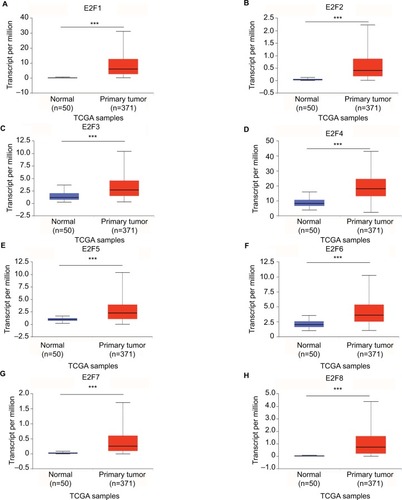
Figure 3 The relationship between E2F mRNA expression and individual HCC cancer stages from TCGA database.
Notes: Expression panels for E2F1 (A), E2F2 (B), E2F3 (C), E2F4 (D), E2F5 (E), E2F6 (F), E2F7 (G), and E2F8 (H) based on individual HCC cancer stages comparing 50 normal individuals and data for 371 HCC patients in TCGA database. Individual cancer stages include liver cancer from stage 1 to stage 4; *P<0.05; **P<0.01; ***P<0.001.
Abbreviations: HCC, hepatocellular carcinoma; TCGA, The Cancer Genome Atlas.
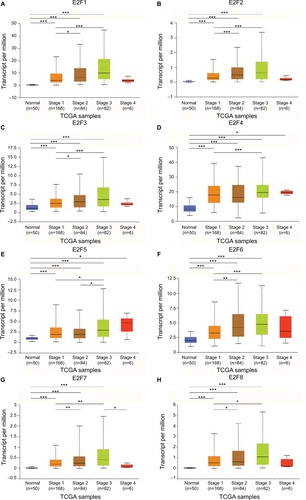
Figure 4 The relationship between E2F mRNA expression and HCC tumor grade from TCGA database.
Notes: Expression panels for E2F1 (A), E2F2 (B), E2F3 (C), E2F4 (D), E2F5 (E), E2F6 (F), E2F7 (G), and E2F8 (H) based on HCC tumor grade comparing 50 normal individuals and data for 371 HCC patients in TCGA database. HCC tumor grade includes liver cancer from grade 1 to grade 4; grade 1: well differentiated, grade 2: moderately differentiated, grade 3: poorly differentiated, grade 4: undifferentiated; *P<0.05; **P<0.01; ***P<0.001.
Abbreviations: HCC, hepatocellular carcinoma; TCGA, The Cancer Genome Atlas.
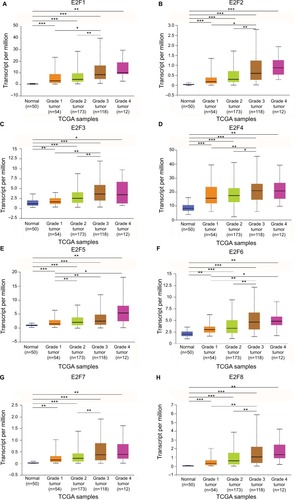
Prognostic value of E2Fs in liver cancer patients
We used Kaplan–Meier plotter (http://kmplot.com/analysis/) to further determine the prognostic values of the mRNA expression of E2Fs in liver cancer patients. The results showed that all eight E2Fs were significantly associated with patient prognosis. First, we analyzed the relationship between the combined mRNA expression of all E2Fs and the prognosis of HCC patients. The survival curves () revealed that a higher level of combined E2F expression predicts a poor prognosis in HCC. Next, we focused on the relationship between the mRNA expression levels of individual E2F members and the prognosis of HCC patients. As shown in , overexpressed mRNA levels of E2F1–E2F8 were significantly related to shorter OS time. These results suggest that the mRNA expression levels of E2Fs may be useful for prediction of HCC patient survival.
Figure 5 Kaplan–Meier curve revealing the OS difference based on E2F mRNA levels in HCC patients.
Notes: (A) Overexpressed mRNA levels of all E2Fs are associated with poor OS in HCC patients. (B–I) E2F1–E2F8 mRNA expression levels are associated with poor OS in HCC patients.
Abbreviations: HCC, hepatocellular carcinoma; OS, overall survival; TCGA, The Cancer Genome Atlas.
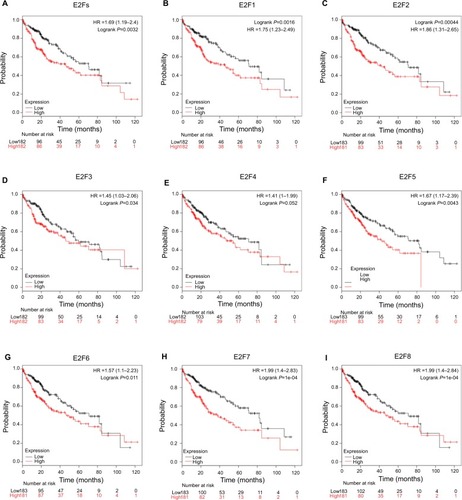
Sequence alterations in E2Fs affect OS and DFS in HCC patients
Next, TCGA database and the c-BioPortal website were applied to further explore E2F sequence alterations and their effects on OS and DFS in HCC patients. As shown in , E2F sequence alterations occurred in 171 samples out of the 360 patients with liver cancer (the total mutation rate was 48%). E2F5, E2F3, and E2F6 were the three genes with the highest rate of sequence alterations, and their mutation rates were 23%, 14%, and 12%, respectively. Further analysis using a Kaplan–Meier plot and log-rank test showed that sequence alterations in E2Fs were associated with worse OS in HCC patients (, P=0.00368). Consistently, alterations in E2Fs were also associated with worse DFS (P=0.0000901). These results indicated that E2F sequence alterations could have an impact on HCC patient prognosis.
Figure 6 E2F expression and mutation analysis in liver cancer (c-BioPortal).
Notes: (A) Oncoprint in c-BioPortal showed the distribution and proportion of samples with alterations in E2Fs. (B) Left panel: E2F alterations were associated with worse overall survival in HCC patients. Right panel: E2F alterations were associated with worse disease-free survival in HCC patients. (C) Networks constructed in c-BioPortal showed the interaction relationship between E2F1/2/3/4/5/6/7 and the 50 most frequently altered neighboring genes.
Abbreviation: HCC, hepatocellular carcinoma.
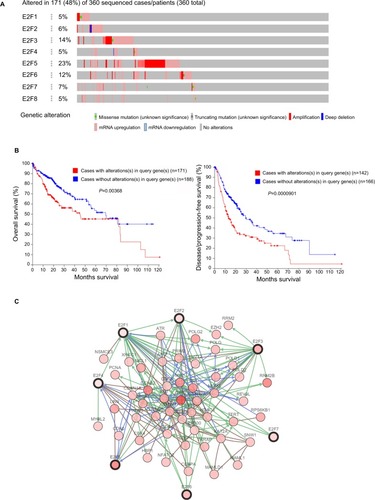
Network analysis of signaling pathways affected by mutations in the E2F family in HCC
We also used c-BioPortal to construct a network for eight E2Fs and the neighboring 50 genes significantly associated with E2Fs. The results showed that the cell cycle-related genes CDC6, TP53, CDK6, CDK4, CCNE2, CDKN1A, and CDKN2A were significantly related to E2F alterations (). Next, GO and KEGG analyses using DAVID were exploited to discover the functional enrichment of E2Fs and their associated genes. GO analysis predicted three main functions of target genes, including biological process (BP), cellular components (CPs), and molecular functions (MFs). The results showed that BPs, such as GO:0006351 transcrip tion, DNA-templated; GO:0090399 replicative senescence; GO:0034644 cellular response to UV; GO:0048146 positive regulation of fibroblasts; and GO:000012 negative regulation of transcription, were remarkably regulated by alterations in E2Fs and the related 50 genes in HCC (). CPs, such as GO:0005667 transcription factor complex; GO:0005634 nucleus; GO:0005654 nucleoplasm; GO:0000307 cyclin-dependent protein kinase; and GO:0070557 PCNA-p21 complex, were prominently associated with E2F alterations (). Last but not least, the alterations also significantly affected MFs, such as GO:0003677 DNA binding; GO:0001047 core promoter binding; GO:0003700 transcription factor activity, sequence-specific DNA binding; GO:0003684 damaged DNA binding; and GO0003887 DNA-directed DNA polymerase activity, in liver cancer cells (). On the other hand, KEGG analysis showed the 20 most relevant pathways associated with E2F alterations and the neighboring 50 genes in HCC. As shown in , ptr04110: Cell Cycle, ptr05161: Hepatitis B, ptr04115: p53 signaling pathway, ptr05203: Viral carcinogenesis, ptr05200: pathways in cancer, ptr04350: TGF-beta signaling pathway, ptr04330: Notch signaling pathway, and ptr04151: PI3K– AKT signaling pathway were involved in tumorigenesis and development of HCC.
Figure 7 GO enrichment analysis of E2Fs and their 50 most frequently altered neighboring genes.
Note: GO functional enrichment analysis predicted three main functions of target genes: (A) BP; (B) CP, and (C) MF.
Abbreviations: BP, biological process; CP, cellular component; GO, Gene Ontology; MF, molecular function.
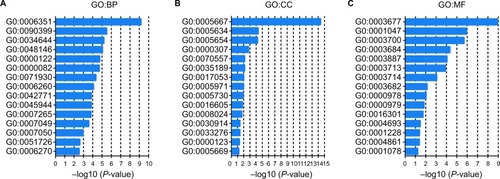
Discussion
E2Fs have been reported to take part in a variety of cancer types because they can regulate many cellular functions related to cell cycle progression.Citation21,Citation34,Citation35 Although some E2F family members have been confirmed to play promising roles in HCC, the distinct roles of E2Fs in the development, progression, and metastasis of HCC remain to be elucidated. In the present study, the expression, mutation, and prognostic values of different E2Fs in HCC patients were analyzed.
E2F1, the classic E2F member, is the most well-studied member of the E2F family. Significant overexpression of E2F1 has been found in HCC tissues compared with nontumorous liver tissues, and high E2F1 immunoexpression was found to be predictive of a poor OS rate in HCC patients. In addition, E2F1 can promote the proliferation of HCC cell lines through activation of B-Myb, stathmin 1, BRCA1, and dbp1, which promote the initiation or progression of HCC.Citation36–Citation39 E2F1 is also regulated by Sirtuin 5 (SIRT5) and miR-17-5 p to promote cell proliferation and invasion in HCC cell lines, and knockdown of E2F1 in HCC cells partially reversed the effect of SIRT5 on promoting cell proliferation and invasion.Citation40,Citation41 E2F1 transcription is upregulated by hepatitis B virus (HBV) core promoter muta tions, which in turn activates SKP2 transcription, leading to downregulation of cell cycle inhibitors and proliferation of HCC.Citation42 Moreover, E2F1 has been found to play a critical antiapoptotic role in both human and rodent liver cancer via counteraction of c-myc-mediated apoptosis and activation of the PIK3CA/Akt/mTOR and c-Myb/COX-2 pathways.Citation43 Paradoxically, E2F1 has also shown tumor-suppressing activity in HCC. Baiz et al observed that nuclear E2F1 expression determined by immunohistochemistry was inversely related to phospho-pRb expression and positively related to the tumor apoptotic index.Citation17 Choi et al found that E2F1 could inhibit HBV life cycle and HBV-mediated HCC by interfering with the control of HBx on the p53 promoter and direct activation of the p53 promoter through its binding site.Citation44 Furthermore, in animal models, the TFDP3/E2F1 pathway was found to promote HCC cell apoptosis by positive regulation of HIF-2α, and the decreased level of HIF-2α was associated with lower OS of HCC patients.Citation45 In view of the above arguments, Farra et al indicated in their review that the proliferative and apoptotic functions of E2F1 in HCC may coexist but the proliferative effect seems to be more pronounced than the apoptotic one.Citation46 However, in our study, higher E2F1 expression was significantly related to tumor stage and poor survival of HCC patients, which indicated that E2F1 may play a tumor promoting role in HCC from the view of prognosis. More studies are needed to further verify the exact role of E2F1 in HCC.
Overexpression of E2F2 has been observed during hepatocarcinogenesis, and disruption of the pRb/E2F pathway and inhibition of apoptosis are major oncogenic events in c-myc/TGFalpha transgenic mice.Citation47 Huang et al found that ANCCA/PRO2000 promoted the growth and invasion of HCC cells in vitro and enhanced the tumorigenicity of HCC cells in vivo via upregulation of E2F2, and miR-520a was an intermediate regulator between ANCCA/PRO2000 and E2F. A regulatory loop formed by ANCCA/PRO2000, miR-520a, and E2F2 is a driving force for HCC development.Citation48 Dong et al observed that overexpression of miR-218 can inhibit HCC cell proliferation and induce cell cycle arrest at the G0/G1 phase checkpoint by downregulating E2F2 via direct binding to its 3′-UTR.Citation49 Consistent with these findings, significant overexpression of E2F2 was found in liver cancer tissues compared with normal tissues and was associated with a poor survival time in all liver cancer patients who were followed up for 120 months in our study.
Significant upregulation of E2F3 was observed in HCC tissues compared with normal controls and was associated with poor prognosis in HCC patients.Citation50,Citation51 Kent et al found that copy number gains in E2F3b resulted in dosage-dependent spontaneous HCC in mice without the involvement of additional organs. Conversely, germ-line loss of E2F3b protected mice against HCC, suggesting that E2F3 is associated with development and progression of HCC.Citation52 Similarly, in the present study, we demonstrated that significantly higher E2F3 expression was present in HCC tissues and was related to tumor stage and worse OS in patients with liver cancer. Recently, targeting of E2F3 by a variety of microRNAs, including miR-144, miR-503, miR-424, miR-214, and miR-363, has been found to inhibit the growth, migration, and invasion of HCC cells, suggesting that E2F3 may be exploited as a novel and promising therapeutic target for HCC treatment.Citation53–Citation57
As an E2F repressor, E2F4 has also been found to be significantly associated with HCC. Park et al found that both microsatellite instability and E2F4 mutations occurred commonly in HCC as well as in colon and gastric cancers, indicating that E2F4 may play a significant role in HCC.Citation58 Yoshida et al observed that gnidimacrin, which exhibits significant antiproliferation activity, could cause G2-phase arrest in human hepatoma HLE cells by repression of cdc2 via induction of p21 and promotion of E2F4 translocation to the nucleus.Citation59 To the best of our knowledge, to date, no studies have reported the expression pattern or prognostic value of E2F4 in HCC. Thus, our study is the first to report significant overexpression of E2F4 in HCC tissues relative to that in normal tissues and to propose that this higher E2F4 expression is significantly correlated with tumor stage and poor survival in HCC patients, in accordance with the other research.
E2F5 had been found to play a potential oncogenic role in HCC. The results from the study of Jiang et al showed that E2F5 was markedly upregulated in primary HCC compared with normal liver tissues, and knockdown of E2F5 in HCC cells reduced their proliferation and metastasis by promoting G0/G1 arrest.Citation19 Similarly, Sun et al found that the transcription factor FOXN3 could inhibit HCC cell proliferation through downregulation of E2F5 expression.Citation60 However, Zou et al demonstrated that HBV could upregulate miR-181a expression, and overexpression of miR-181a in hepatoma cells promoted cell growth in vitro and tumor formation in vivo by targeting E2F5. Conversely, inhibition of miR-181a suppressed the proliferation of SMMC-7721 cells, and E2F5 inhibition induced cell growth and rescued the suppressive effect of the miR-181a inhibitor on SMMC-7721 cell proliferation,Citation61 suggesting that E2F5 may play a complicated role in HCC, similar to that of E2F1. In the present study, we found that E2F5 expression in HCC tissue was higher than that in normal liver tissue and related to tumor stage. Moreover, high E2F5 expression was markedly associated with worse OS in all the liver cancer patients, which supported the notion that E2F5 plays an oncogenic role in HCC, but the exact role played by E2F5 in HCC should be further evaluated.
Higher E2F6 expression has been found in many malignancies, including non-small-cell lung cancer and acute lymphoblastic leukemia.Citation62,Citation63 However, evidence of the relationship between E2F6 expression and its prognosis value in HCC patients has rarely been reported. Similarly, in our present study, the expression of E2F6 in HCC tissues was found for the first time to be higher than that in normal tissues, and this expression was associated with tumor stage in patients with HCC. HCC patients with higher E2F6 expression had a worse OS than patients with lower E2F6 expression.
Similar to E2F6, research on the correlation of E2F7 with HCC has rarely been reported. However, E2F7 has organizational and functional properties similar to those of E2F8, which is a tumor activator in HCC,Citation20 and they share a variety of transcriptional targets via the formation of homodimers and heterodimers.Citation64,Citation65 Furthermore, E2F7 has been found to participate in the metabolism and proliferation involved in liver regeneration.Citation66 All these studies indicate that E2F7 may have a close relationship with HCC. Likewise, similar to E2F4 and E2F6, our study is the first to report that higher E2F7 expression is present in HCC tissues compared with normal liver tissues and is markedly related to tumor stage and poor OS in liver cancer patients.
As discussed above, E2F8 has been correlated with HCC development. Deng et al observed that overexpression of E2F8 promoted cell proliferation, colony formation, and tumorigenicity in different HCC cell lines by regulating cyclin D1 transcription and promoting the accumulation of S-phase cells, while knockdown of E2F8 reversed these phenotypes.Citation20 Likewise, in our study, higher E2F8 expression was observed in HCC tissues and was significantly correlated with tumor stage and worse OS in liver cancer patients. Interestingly, Kent et al found a specific tumor suppressor role of E2F8 in HCC. They observed that overexpression of wild-type E2F8 but not a DNA binding defective mutant of E2F8 inhibited the proliferation of HepG2 cells. Moreover, specific deletion of E2F8 promoted DEN-induced HCC and in combination with loss of E2F7 led to spontaneous HCC formation in mice. Furthermore, inactivation of the E2F8 DNA-binding activity in 8DBD mice was sufficient to promote HCC in vivo.Citation67 Taken together, similar to E2F1 and E2F5, E2F8 can not only enhance cancer progression but can also protect against cancer initiation, which is dependent on the specific context.
As mentioned above, E2Fs are conventionally classified into the three categories based on their functional properties and structural features.Citation8,Citation68–Citation70 Nevertheless, it should be emphasized that the basic classification of mammalian E2Fs is generally dependent on in vitro study and lack of in vivo identification, so the elegant classification may not be sufficient to highlight their sophisticated roles.Citation10,Citation68,Citation71 For example, genome-wide expression approaches identify that E2F1–E2F3 could function as direct repressors of transcription independent of pocket proteinsCitation72 and E2F7 and E2F8 can form complex with the hypoxia-inducible factor 1 and mediate angiogenesis through transcriptional activation of vascular endothelial growth factor.Citation73 In our present paper, higher expressions of E2F6, E2F7, and E2F8 were observed in HCC tissues and were significantly correlated to tumor stages and worse OS in liver cancer patients, suggesting that they may play oncogenic role in HCC. Moreover, in vitro studies by Deng et al had demonstrated that overexpression of E2F8 promoted cell proliferation, colony formation, and tumorigenicity in different HCC cell lines by regulating transcription of cyclin D1 and promoting accumulation of S-phase cells, while knockdown of E2F8 reversed these phenotypes.Citation20 Therefore, although there is a possibility that upregulation of “inhibitor” E2F members is reactive to the upregulation of the proliferative E2Fs, which is an attempt to downregulate cell proliferation, results from our paper indicated that “inhibitors” E2F members may play a role in promoting tumorigenesis as oncogenes in HCC. Further experiments should be done to evaluate the exact role played by “inhibitors” E2F members.
Our study has some limitations. First, we found that E2Fs may be exploited as promising diagnostic and prognostic markers in human HCC. HCC patients with cirrhosis are very common, and there is no doubt that a comparison of E2Fs between cirrhosis and HCC will increase the marker specificity of E2Fs. However, because all the data were retrieved from published literature (reported in the ONCO-MINE, UALCAN, and c-BioPortal databases), we could not obtain more data showing E2F mRNA expression in patients with HCC and in patients with cirrhosis; thus, we cannot make this comparison based on the present data. Second, despite overexpressed mRNA levels of E2F1–E2F8 had been shown to be significantly related to shorter OS time of HCC patients by Kaplan–Meier plotter, results of multivariate analysis showed that only E2F5 and E2F6 served as independent factors and they may be a driver in the tumor progression (). However, multivariate analysis also revealed that other E2Fs may not be independent prognostic factors, which indicated that these other E2Fs may be a passenger that altered with the change of stage/grade in tumor or expression of E2F5/E2F6. Therefore, we are not yet able to determine whether E2Fs are driving factors in tumorigenesis or just associated with the change in tumor stage/grade, and further experiments such as overexpression/knockdown E2Fs on cell or animal models need to be done to reveal their roles during the HCC progression. Examining the E2F levels in the blood of HCC patients and demonstrating that the mRNA expression of E2Fs in the blood has the same predictive value as the mRNA expression of E2Fs in tissue will promote practical (clinical) use of our findings in the future. In fact, studies performed by Al Ahmed et al and Pipinikas et al have shown that blood E2F3 mRNA levels in lung cancer patients and prostate cancer patients can be measured by quantitative RT-PCR;Citation74,Citation75 based on their findings, it is reasonable to speculate that E2F levels in the blood of HCC patients can also be measured by quantitative RT-PCR, and the prediction values of blood E2F mRNA expression levels in HCC patients should be explored in future research.
In summary, the expression, mutation, and prognostic values of different E2Fs in HCC patients were systemically analyzed. Our results showed that all E2F family members were highly expressed in HCC and were associated with poor survival of HCC patients. Thus, E2Fs could be exploited as diagnostic molecular markers and prognostic markers in the management of HCC treatment.
Author contributions
All authors contributed to data analysis, drafting or revising the article, gave final approval of the version to be published, and agree to be accountable for all aspects of the work.
Acknowledgments
This study was funded in part by grants from the International Cooperation Project of Guangzhou Science and Technology Program (2016201604030021), Major Project of Collaborative Innovation of Guangzhou Science and Technology Program (201704020175), and National Natural Science Foundation of China (81872006).
Disclosure
The authors report no conflicts of interest in this work.
Supplementary materials
Table S1 Multivariate analysis of overall survival in 371 HCC specimens
References
- TorreLABrayFSiegelRLFerlayJLortet-TieulentJJemalAGlobal cancer statistics, 2012CA Cancer J Clin20156528710825651787
- ChenWZhengRBaadePDCancer statistics in China, 2015CA Cancer J Clin201666211513226808342
- ClarkTMaximinSMeierJPokharelSBhargavaPHepatocellular carcinoma: review of epidemiology, screening, imaging diagnosis, response assessment, and treatmentCurr Probl Diagn Radiol201544647948625979220
- MenradHWernoCSchmidTRoles of hypoxia-inducible factor-1alpha (HIF-1alpha) versus HIF-2alpha in the survival of hepatocellular tumor spheroidsHepatology20105162183219220513003
- DaiCXGaoQQiuSJHypoxia-inducible factor-1 alpha, in association with inflammation, angiogenesis and MYC, is a critical prognostic factor in patients with HCC after surgeryBMC Cancer20099141819948069
- HuangYWangHLianYUpregulation of kinesin family member 4A enhanced cell proliferation via activation of Akt signaling and predicted a poor prognosis in hepatocellular carcinomaCell Death Dis20189214129396392
- ZhanLHuangCMengXMPromising roles of mammalian E2Fs in hepatocellular carcinomaCell Signal20142651075108124440307
- AttwoollCLazzerini DenchiEHelinKThe E2F family: specific functions and overlapping interestsEMBO J200423244709471615538380
- RenBCamHTakahashiYE2F integrates cell cycle progression with DNA repair, replication, and G(2)/M checkpointsGenes Dev200216224525611799067
- DimovaDKDysonNJThe E2F transcriptional network: old acquaintances with new facesOncogene200524172810282615838517
- KauffmannSLegrandMGeoffroyPFritigBBiological function of “pathogenesis-related” proteins: four PR proteins of tobacco have 1,3-beta-glucanase activityEMBO J19876113209321216453802
- ButcherDTAllistonTWeaverVMA tense situation: forcing tumour progressionNat Rev Cancer20099210812219165226
- Hazar-RethinamMEndo-MunozLGannonOSaundersNThe role of the E2F transcription factor family in UV-induced apoptosisInt J Mol Sci201112128947896022272113
- HarbourJWLuoRXDei SantiAPostigoAADeanDCCDK phosphorylation triggers sequential intramolecular interactions that progressively block Rb functions as cells move through G1Cell199998685986910499802
- YangMWuSJiaJMayWSJAZ mediates G1 cell cycle arrest by interacting with and inhibiting E2F1Cell Cycle201110142390239921715977
- JiangXNevinsJRShatsIChiJTE2F1-mediated induction of NFYB attenuates apoptosis via joint regulation of a pro-survival transcriptional programPLoS One2015106e012795126039627
- BaizDDapasBFarraRBortezomib effect on E2F and cyclin family members in human hepatocellular carcinoma cell linesWorld J Gastroenterol201420379580324574752
- LiWNiGXZhangPZhangZXLiWWuQCharacterization of E2F3a function in HepG2 liver cancer cellsJ Cell Biochem201011151244125120803551
- JiangYYimSHXuHDA potential oncogenic role of the commonly observed E2F5 overexpression in hepatocellular carcinomaWorld J Gastroenterol201117447047721274376
- DengQWangQZongWYE2f8 contributes to human hepatocellular carcinoma via regulating cell proliferationCancer Res201070278279120068156
- JohnsonDGDegregoriJPutting the oncogenic and tumor suppressive activities of E2F into contextCurr Mol Med20066773173817100599
- RhodesDRYuJShankerKONCOMINE: a cancer micro-array database and integrated data-mining platformNeoplasia2004611615068665
- ChandrashekarDSBashelBBalasubramanyaSAHUALCAN: a portal for facilitating tumor subgroup gene expression and survival analysesNeoplasia201719864965828732212
- SzászAMLánczkyANagyÁCross-validation of survival associated biomarkers in gastric cancer using transcriptomic data of 1,065 patientsOncotarget2016731493224933327384994
- GyörffyBLanczkyAEklundACAn online survival analysis tool to rapidly assess the effect of 22,277 genes on breast cancer prognosis using microarray data of 1,809 patientsBreast Cancer Res Treat2010123372573120020197
- GyőrffyBLánczkyASzállásiZImplementing an online tool for genome-wide validation of survival-associated biomarkers in ovarian-cancer using microarray data from 1287 patientsEndocr Relat Cancer201219219720822277193
- GyőrffyBSurowiakPBudcziesJLánczkyAOnline survival analysis software to assess the prognostic value of biomarkers using transcriptomic data in non-small-cell lung cancerPLoS One2013812e8224124367507
- TomczakKCzerwińskaPWiznerowiczMThe Cancer Genome Atlas (TCGA): an immeasurable source of knowledgeContemp Oncol (Pozn)2015191A6877
- GaoJAksoyBADogrusozUIntegrative analysis of complex cancer genomics and clinical profiles using the cBioPortalSci Signal20136269pl123550210
- ShermanBTHuangDawTanQDAVID Knowledgebase: a gene-centered database integrating heterogeneous gene annotation resources to facilitate high-throughput gene functional analysisBMC Bioinformatics20078142617980028
- ChenXCheungSTSoSGene expression patterns in human liver cancersMol Biol Cell20021361929193912058060
- RoesslerSJiaHLBudhuAA unique metastasis gene signature enables prediction of tumor relapse in early-stage hepatocellular carcinoma patientsCancer Res20107024102021021221159642
- WurmbachEChenYBKhitrovGGenome-wide molecular profiles of HCV-induced dysplasia and hepatocellular carcinomaHepatology200745493894717393520
- ChenHZTsaiSYLeoneGEmerging roles of E2Fs in cancer: an exit from cell cycle controlNat Rev Cancer200991178579719851314
- TsantoulisPKGorgoulisVGInvolvement of E2F transcription factor family in cancerEur J Cancer200541162403241416213134
- NakajimaTYasuiKZenKActivation of B-Myb by E2F1 in hepatocellular carcinomaHepatol Res200838988618624722
- ChenYLUenYHLiCFThe E2F transcription factor 1 trans-actives stathmin 1 in hepatocellular carcinomaAnn Surg Oncol201320124041405422911364
- ChenQWangLJiangME2F1interactive with BRCA1 pathway induces HCC two different small molecule metabolism or cell cycle regulation via mitochondrion or CD4+ T to cytosolJ Cell Physiol201823321213122128474358
- ArakawaYKajinoKKanoSTranscription of dbpA, a Y box binding protein, is positively regulated by E2F1: implications in hepatocarcinogenesisBiochem Biophys Res Commun2004322129730215313206
- El TayebiHMOmarKHegySRepression of miR-17-5p with elevated expression of E2F-1 and c-myc in non-metastatic hepatocellular carcinoma and enhancement of cell growth upon reversing this expression patternBiochem Biophys Res Commun2013434342142723583198
- ChangLXiLLiuYLiuRWuZJianZSIRT5 promotes cell proliferation and invasion in hepatocellular carcinoma by targeting E2F1Mol Med Rep201817134229115436
- HuangYTaiAWTongSLokASHBV core promoter mutations promote cellular proliferation through E2F1-mediated upregulation of S-phase kinase-associated protein 2 transcriptionJ Hepatol20135861068107323348237
- LaduSCalvisiDFConnerEAFarinaMFactorVMThorgeirssonSSE2F1 inhibits c-Myc-driven apoptosis via PIK3CA/Akt/mTOR and COX-2 in a mouse model of human liver cancerGastroenterology200813541322133218722373
- ChoiMLeeHRhoHME2F1 activates the human p53 promoter and overcomes the repressive effect of hepatitis B viral X protein (HBx) on the p53 promoterIUBMB Life200253630931712625370
- HxSXuYYangXRHIF-2α inhibits hepatocellular carcinoma growth through the TFDP3/E2F1-dependent apoptotic pathwayHepatology2013573108823212661
- FarraRGrassiGTononFThe role of the transcription factor E2F1 in hepatocellular carcinomaCurr Drug Deliv201714227228127109336
- Santoni-RugiuEJensenMRThorgeirssonSSDisruption of the pRb/E2F pathway and inhibition of apoptosis are major oncogenic events in liver constitutively expressing c-myc and transforming growth factor alphaCancer Res19985811239426068
- HuangJYangJLeiYAn ANCCA/PRO2000-miR-520a-E2F2 regulatory loop as a driving force for the development of hepatocellular carcinomaOncogenesis201655e22927239961
- DongYZouJSuSMicroRNA-218 and microRNA-520a inhibit cell proliferation by downregulating E2F2 in hepatocellular carcinomaMol Med Rep20151211016102225816091
- ZengXYinFLiuXUpregulation of E2F transcription factor 3 is associated with poor prognosis in hepatocellular carcinomaOncol Rep20143131139114624402082
- LiuLXJiangHCLiuZHExpression of cell cycle/growth regulator genes in human hepatocellular carcinoma and adjacent normal liver tissuesOncol Rep20031061771177514534694
- KentLNBaeSTsaiSYDosage-dependent copy number gains in E2F1 and E2F3 drive hepatocellular carcinomaJ Clin Invest2017127383084228134624
- CaoTLiHHuYMaDCaiXmiR-144 suppresses the proliferation and metastasis of hepatocellular carcinoma by targeting E2F3Tumour Biol20143511107591076425073510
- XiaoFZhangWChenLMicroRNA-503 inhibits the G1/S transition by downregulating cyclin D3 and E2F3 in hepatocellular carcinomaJ Transl Med20131119523967867
- YangHZhengWShuaiXMicroRNA-424 inhibits Akt3/E2F3 axis and tumor growth in hepatocellular carcinomaOncotarget20156292773626315541
- YangYChangSZhaoZMicroRNA-214 suppresses the proliferation of human hepatocellular carcinoma cells by targeting E2F3Oncol Lett20151063779378426788207
- YeJZhangWLiuSLiuYLiuKmiR-363 inhibits the growth, migration and invasion of hepatocellular carcinoma cells by regulating E2F3Oncol Rep20173863677368429039555
- ParkYMChoiJYBaeSHMicrosatellite instability and mutations of E2F-4 in hepatocellular carcinoma from KoreaHepatol Res200017210211110707004
- YoshidaMMatsuiYIizukaAIkarashiYAaIG2-phase arrest through p21(WAF1/Cip1) induction and cdc2 repression by gnidimacrin in human hepatoma HLE cellsAnticancer Res20092941349135419414386
- SunJLiHHuoQThe transcription factor FOXN3 inhibits cell proliferation by downregulating E2F5 expression in hepatocellular carcinoma cellsOncotarget2016728435344354527259277
- ZouCLiYCaoYUp-regulated microRNA-181a induces carcinogenesis in hepatitis B virus-related hepatocellular carcinoma by targeting E2F5BMC Cancer2014149724529171
- ArmstrongSAStauntonJESilvermanLBMLL translocations specify a distinct gene expression profile that distinguishes a unique leukemiaNat Genet2002301414711731795
- LammensTLiJLeoneGDeVeylderLAtypical E2Fs: new players in the E2F transcription factor familyTrends Cell Biol200919311111819201609
- LoganNGrahamAZhaoXE2F-8: an E2F family member with a similar organization of DNA-binding domains to E2F-7Oncogene200524315000500415897886
- MoonNSDysonNE2F7 and E2f8 keep the E2F family in balanceDev Cell20081411318194644
- LiuHXFangYHuYGonzalezFJFangJWanYJPPARβ regulates liver regeneration by modulating Akt and E2F signalingPLoS One201386e6564423823620
- KentLNRakijasJBPanditSKE2f8 mediates tumor suppression in postnatal liver developmentJ Clin Invest201612682955296927454291
- CamHDynlachtBDEmerging roles for E2F: beyond the G1/S transition and DNA replicationCancer Cell20033431131612726857
- GaubatzSWoodJGLivingstonDMUnusual proliferation arrest and transcriptional control properties of a newly discovered E2F family member, E2F-6Proc Natl Acad Sci U S A19989516919091959689056
- CarvajalLAHamardPJTonnessenCManfrediJJE2F7, a novel target, is up-regulated by p53 and mediates DNA damage-dependent transcriptional repressionGenes Dev201226141533154522802528
- WenzelPLChongJLSáenz-RoblesMTCell proliferation in the absence of E2F1-3Dev Biol20113511354521185283
- BrackenAPCiroMCocitoAHelinKE2F target genes: unraveling the biologyTrends Biochem Sci200429840941715362224
- WeijtsBGBakkerWJCornelissenPWE2F7 and E2f8 promote angiogenesis through transcriptional activation of VEGFA in cooperation with HIF1EMBO J201231193871388422903062
- PipinikasCPNairSBKirbyRSNdCFenskeCDMeasurement of blood E2F3 mRNA in prostate cancer by quantitative RT-PCR: a preliminary studyBiomarkers200712554155717701752
- Al AhmedHANadaOE2F3 transcription factor: a promising bio-marker in lung cancerCancer Biomark2017191212628269748

